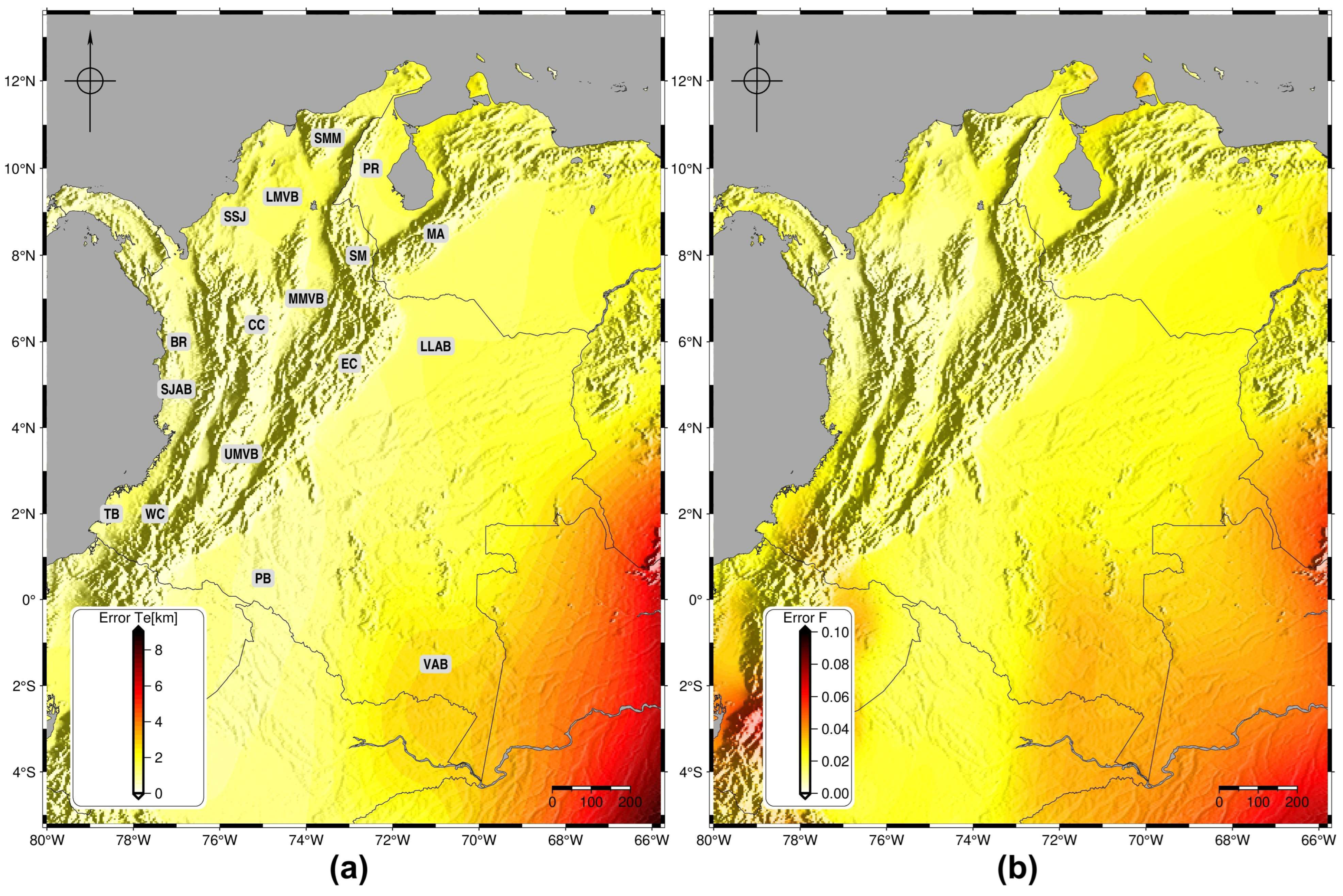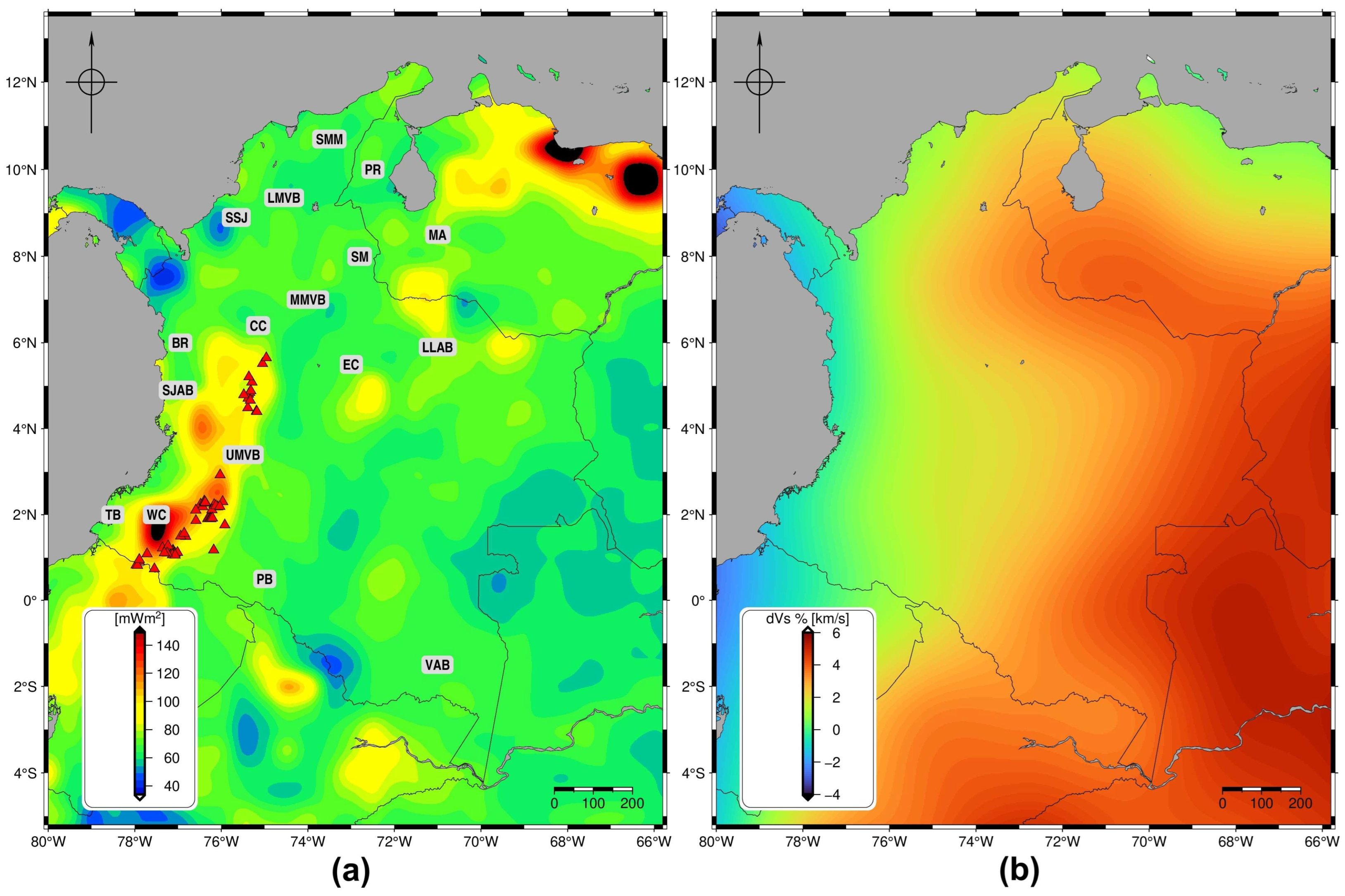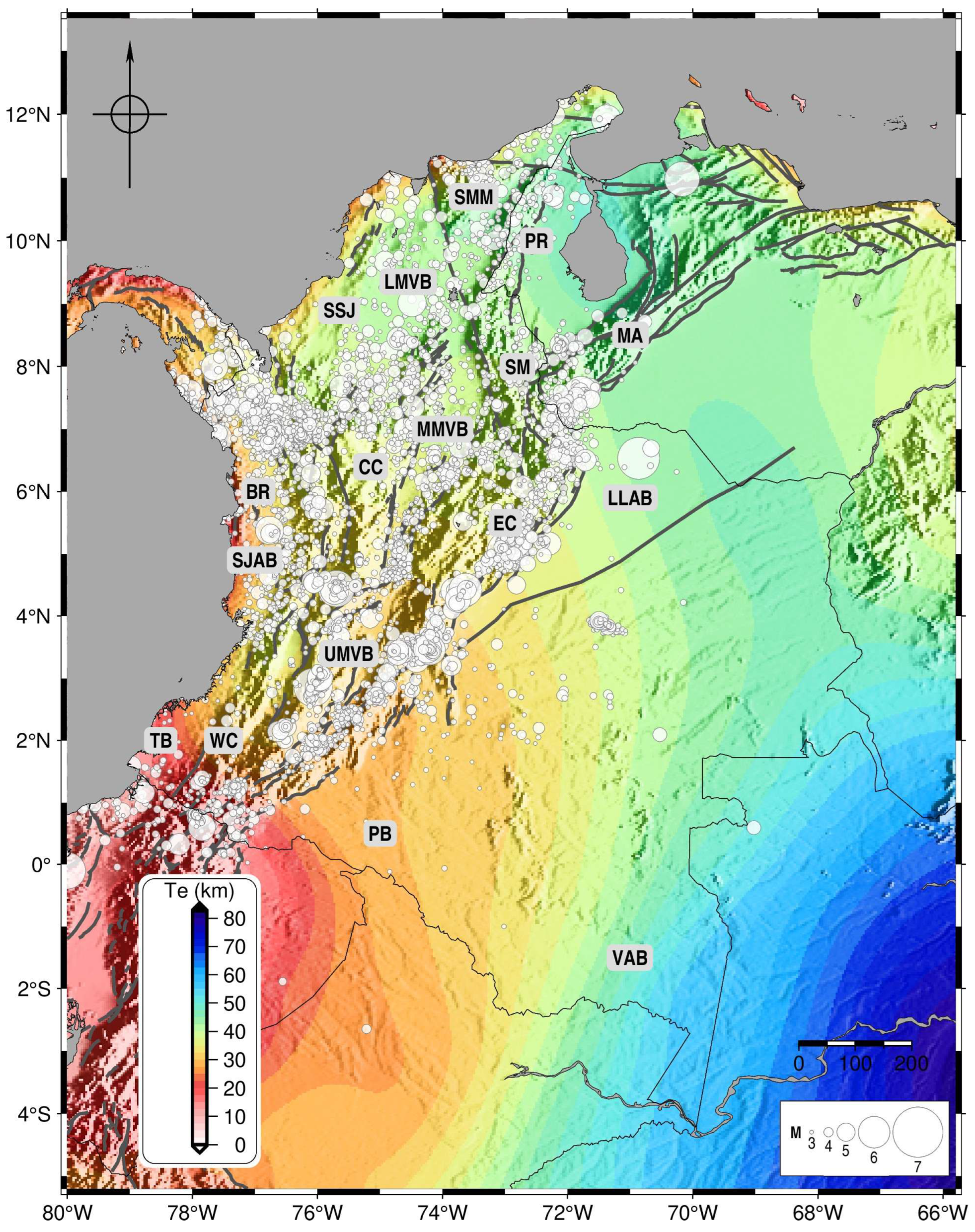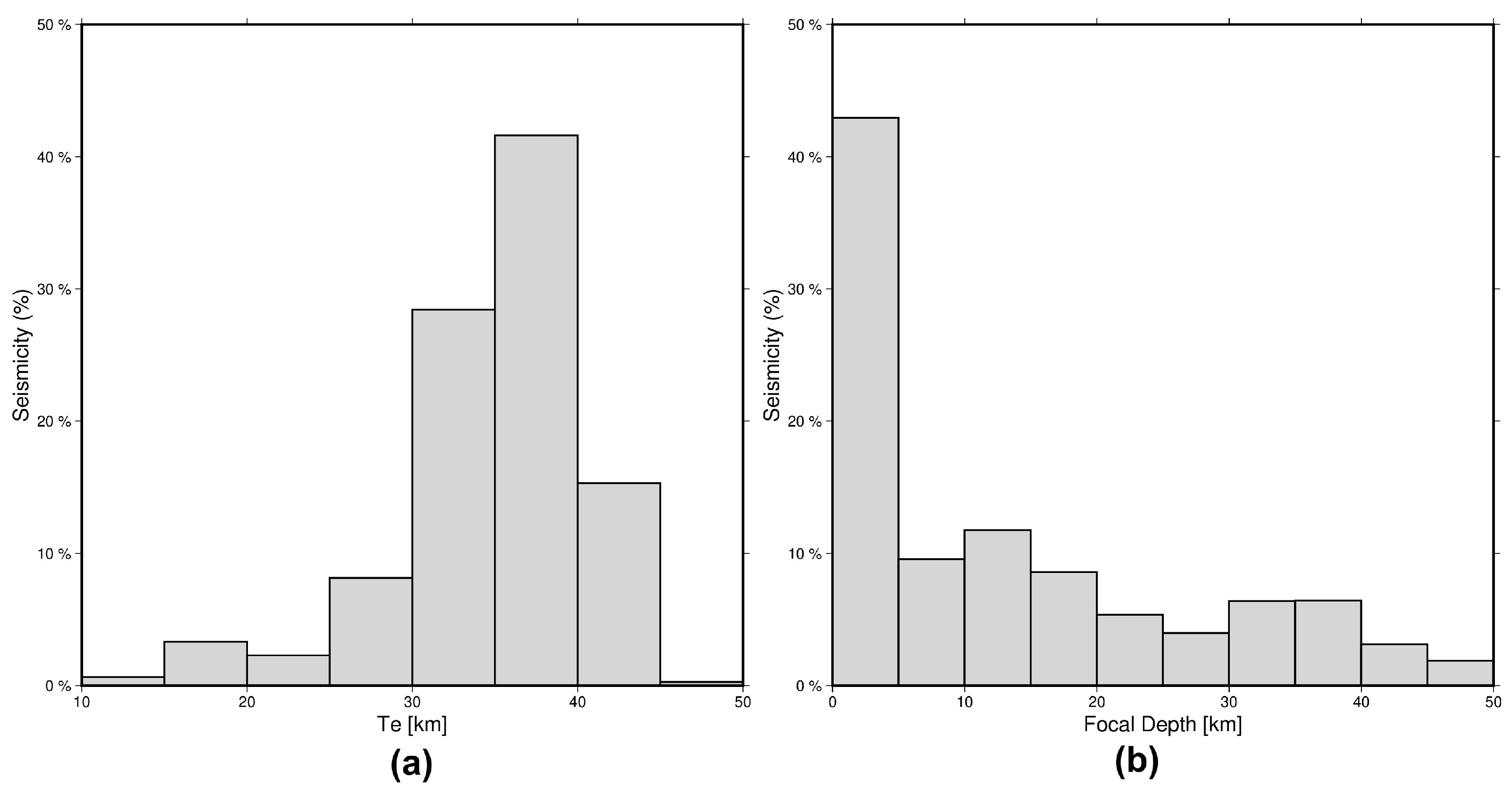Effective Elastic Thickness in Northern South America
Abstract
1. Introduction
2. Tectonic Setting

3. Data and Methodology
4. Results and Discussion
4.1. Spatial Variation of Te and Loading Ratio (F)
4.2. Comparison with Previous Results
4.3. Te, Surface Heat Flow, and Seismic Velocity
4.4. Te and Seismicity
5. Conclusions
Author Contributions
Funding
Institutional Review Board Statement
Informed Consent Statement
Data Availability Statement
Acknowledgments
Conflicts of Interest
References
- Burov, E.B.; Diament, M. The effective elastic thickness (Te) of continental lithosphere: What does it really mean? J. Geophys. Res. Solid Earth 1995, 100, 3905–3927. [Google Scholar] [CrossRef]
- Tassara, A.; Swain, C.; Hackney, R.; Kirby, J. Elastic thickness structure of South America estimated using wavelets and satellite-derived gravity data. Earth Planet. Sci. Lett. 2007, 253, 17–36. [Google Scholar] [CrossRef]
- Karato, S. Deformation of Earth Materials: An Introduction to the Rheology of Solid Earth; Cambridge University Press: Cambridge, UK, 2008. [Google Scholar] [CrossRef]
- Artemieva, I. The Lithosphere: An Interdisciplinary Approach; Cambridge University Press: Cambridge, UK, 2011. [Google Scholar] [CrossRef]
- Burov, E.B. Rheology and strength of the lithosphere. Mar. Pet. Geol. 2011, 28, 1402–1443. [Google Scholar] [CrossRef]
- Watts, A.B. Isostasy and Flexure of the Lithosphere|Solid Earth Geophysics, 1st ed.; Cambridge University Press: Cambridge, UK, 2001. [Google Scholar]
- Watts, A.B.; Burov, E.B. Lithospheric strength and its relationship to the elastic and seismogenic layer thickness. Earth Planet. Sci. Lett. 2003, 213, 113–131. [Google Scholar] [CrossRef]
- Audet, P.; Mareschal, J.-C. Wavelet analysis of the coherence between Bouguer gravity and topography: Application to the elastic thickness anisotropy in the Canadian Shield. Geophys. J. Int. 2007, 168, 287–298. [Google Scholar] [CrossRef]
- Lowry, A.R.; Smith, R.B. Strength and rheology of the western U.S. Cordillera. J. Geophys. Res. Solid Earth 1995, 100, 17947–17963. [Google Scholar] [CrossRef]
- Audet, P.; Bürgmann, R. Dominant role of tectonic inheritance in supercontinent cycles. Nat. Geosci. 2011, 4, 184–187. [Google Scholar] [CrossRef]
- Kirby, J. Spectral Methods for the Estimation of the Effective Elastic Thickness of the Lithosphere, Advances in Geophysical and Environmental Mechanics and Mathematics; Springer International Publishing: Cham, Switzerland, 2022. [Google Scholar] [CrossRef]
- Kirby, J.F. Estimation of the effective elastic thickness of the lithosphere using inverse spectral methods: The state of the art. Tectonophysics 2014, 631, 87–116. [Google Scholar] [CrossRef]
- Lewis, B.T.R.; Dorman, L.M. Experimental isostasy: 2. An isostatic model for the U.S.A. derived from gravity and topographic data. J. Geophys. Res. (1896-1977) 1970, 75, 3367–3386. [Google Scholar] [CrossRef]
- Banks, R.J.; Parker, R.L.; Huestis, S.P. Isostatic Compensation on a Continental Scale: Local Versus Regional Mechanisms. Geophys. J. Int. 1977, 51, 431–452. [Google Scholar] [CrossRef]
- Forsyth, D.W. Subsurface loading and estimates of the flexural rigidity of continental lithosphere. J. Geophys. Res. Solid Earth 1985, 90, 12623–12632. [Google Scholar] [CrossRef]
- McKenzie, D.; Fairhead, D. Estimates of the effective elastic thickness of the continental lithosphere from Bouguer and free air gravity anomalies. J. Geophys. Res. Solid Earth 1997, 102, 27523–27552. [Google Scholar] [CrossRef]
- McKenzie, D. Estimating Te in the presence of internal loads. J. Geophys. Res. Solid Earth 2003, 108, 1–21. [Google Scholar] [CrossRef]
- Pérez-Gussinyé, M.; Lowry, A.R.; Watts, A.B. Effective elastic thickness of South America and its implications for intracontinental deformation. Geochem. Geophys. Geosystems 2007, 8, 1–22. [Google Scholar] [CrossRef]
- Jiménez-Díaz, A.; Ruiz, J.; Pérez-Gussinyé, M.; Kirby, J.F.; Álvarez-Gómez, J.A.; Tejero, R.; Capote, R. Spatial variations of effective elastic thickness of the lithosphere in Central America and surrounding regions. Earth Planet. Sci. Lett. 2014, 391, 55–66. [Google Scholar] [CrossRef]
- Stewart, J.; Watts, A.B. Gravity anomalies and spatial variations of flexural rigidity at mountain ranges. J. Geophys. Res. Solid Earth 1997, 102, 5327–5352. [Google Scholar] [CrossRef]
- Galán, R.; Casallas, I. Determination of effective elastic thickness of the Colombian Andes using satellite-derived gravity data. Earth Sci. Res. J. 2010, 14, 7–16. [Google Scholar] [CrossRef]
- Ojeda, G.Y.; Whitman, D. Effect of windowing on lithosphere elastic thickness estimates obtained via the coherence method: Results from northern South America. J. Geophys. Res. Solid Earth 2002, 107, ETG 3-1–ETG 3-12. [Google Scholar] [CrossRef]
- Audet, P. Toward mapping the effective elastic thickness of planetary lithospheres from a spherical wavelet analysis of gravity and topography. Phys. Earth Planet. Inter. 2014, 226, 48–82. [Google Scholar] [CrossRef]
- Lu, Z.; Li, C.-F.; Zhu, S.; Audet, P. Effective elastic thickness over the Chinese mainland and surroundings estimated from a joint inversion of Bouguer admittance and coherence. Phys. Earth Planet. Inter. 2020, 301, 106456. [Google Scholar] [CrossRef]
- Mora-Páez, H.; Kellogg, J.N.; Freymueller, J.T.; Mencin, D.; Fernandes, R.M.S.; Diederix, H.; LaFemina, P.; Cardona-Piedrahita, L.; Lizarazo, S.; Peláez-Gaviria, J.-R.; et al. Crustal deformation in the northern Andes—A new GPS velocity field. J. S. Am. Earth Sci. 2019, 89, 76–91. [Google Scholar] [CrossRef]
- Cortés, M.; Angelier, J. Current states of stress in the northern Andes as indicated by focal mechanisms of earthquakes. Tectonophysics 2005, 403, 29–58. [Google Scholar] [CrossRef]
- Cortés, M.; Colletta, B.; Angelier, J. Structure and tectonics of the central segment of the Eastern Cordillera of Colombia. J. S. Am. Earth Sci. Tecton. Evol. Colomb. Andes 2006, 21, 437–465. [Google Scholar] [CrossRef]
- Restrepo, J.J.; Toussaint, J.F. Terranes and Continental Accretion in the Colombian Andes. Epis. J. Int. Geosci. 1988, 11, 189–193. [Google Scholar] [CrossRef]
- Redwood, S.D. The Geology of the Panama-Chocó Arc. In Geology and Tectonics of Northwestern South America: The Pacific-Caribbean-Andean Junction; Cediel, F., Shaw, R.P., Eds.; Springer International Publishing: Cham, Switzerland, 2019; pp. 901–932. [Google Scholar] [CrossRef]
- Taboada, A.; Rivera, L.A.; Fuenzalida, A.; Cisternas, A.; Philip, H.; Bijwaard, H.; Olaya, J.; Rivera, C. Geodynamics of the northern Andes: Subductions and intracontinental deformation (Colombia). Tectonics 2000, 19, 787–813. [Google Scholar] [CrossRef]
- Suter, F.; Sartori, M.; Neuwerth, R.; Gorin, G. Structural imprints at the front of the Chocó-Panamá indenter: Field data from the North Cauca Valley Basin, Central Colombia. Tectonophysics 2008, 460, 134–157. [Google Scholar] [CrossRef]
- Cortés, M.; Angelier, J.; Colletta, B. Paleostress evolution of the northern Andes (Eastern Cordillera of Colombia): Implications on plate kinematics of the South Caribbean region. Tectonics 2005, 24, TC1008. [Google Scholar] [CrossRef]
- Trenkamp, R.; Kellogg, J.N.; Freymueller, J.T.; Mora, H.P. Wide plate margin deformation, southern Central America and northwestern South America, CASA GPS observations. J. S. Am. Earth Sci. 2002, 15, 157–171. [Google Scholar] [CrossRef]
- Veloza, G.; Styron, R.; Taylor, M.; Mora, A. Open-source archive of active faults for northwest South America. GSAT 2012, 22, 4–10. [Google Scholar] [CrossRef]
- Pennington, W.D. Subduction of the Eastern Panama Basin and seismotectonics of northwestern South America. J. Geophys. Res. Solid Earth 1981, 86, 10753–10770. [Google Scholar] [CrossRef]
- Cediel, F.; Shaw, R.P.; Cáceres, C. Tectonic Assembly of the Northern Andean Block. In The Circum-Gulf of Mexico and the Caribbean: Hydrocarbon Habitats, Basin Formation and Plate Tectonics; Bartolini, C., Buffler, R.T., Blickwede, J.F., Eds.; American Association of Petroleum Geologists: Tulsa, OK, USA, 2003. [Google Scholar] [CrossRef]
- Backé, G.; Dhont, D.; Hervouët, Y. Spatial and temporal relationships between compression, strike-slip and extension in the Central Venezuelan Andes: Clues for Plio-Quaternary tectonic escape. Tectonophysics 2006, 425, 25–53. [Google Scholar] [CrossRef]
- Grösser, J.R. Geotectonic evolution of the Western Cordillera of Colombia: New aspects from geochemical data on volcanic rocks. J. S. Am. Earth Sci. 1989, 2, 359–369. [Google Scholar] [CrossRef]
- Gómez, J.; Núñez–Tello, A.; Mateus–Zabala, D.; Alcárcel–Gutiérrez, F.A.; Lasso–Muñoz, R.M.; Marín–Rincón, E.; Marroquín–Gómez, M.P. Physiographic and geological setting of the Colombian territory. In The Geology of Colombia, Volume 1 Proterozoic–Paleozoic; Gómez, J., Mateus–Zabala, D., Eds.; Publicaciones Geológicas Especiales 35; Servicio Geológico Colombiano: Bogotá, Colombia, 2020; pp. 1–16. [Google Scholar] [CrossRef]
- Cardona, A.; Valencia, V.A.; Bayona, G.; Duque, J.; Ducea, M.; Gehrels, G.; Jaramillo, C.; Montes, C.; Ojeda, G.; Ruiz, J. Early-subduction-related orogeny in the northern Andes: Turonian to Eocene magmatic and provenance record in the Santa Marta Massif and Rancheria Basin, northern Colombia. Terra Nova 2011, 23, 26–34. [Google Scholar] [CrossRef]
- Parra, M.; Echeverri, S.; Patiño, A.M.; Ramírez, J.C.; Mora, A.; Sobel, E.R.; Almendral, A.; Pardo–Trujillo, A. Cenozoic evolution of the Sierra Nevada de Santa Marta, Colombia. In The Geology of Colombia, Volume 3 Paleogene–Neogene; Gómez, J., Mateus–Zabala, D., Eds.; Publicaciones Geológicas Especiales 37; Servicio Geológico Colombiano: Bogotá, Colombia, 2020; pp. 185–213. [Google Scholar] [CrossRef]
- Montes, C.; Guzman, G.; Bayona, G.; Cardona, A.; Valencia, V.; Jaramillo, C. Clockwise rotation of the Santa Marta massif and simultaneous Paleogene to Neogene deformation of the Plato-San Jorge and Cesar-Ranchería basins. J. S. Am. Earth Sci. Sierra Nev. Santa Marta Adjac. Basins 2010, 29, 832–848. [Google Scholar] [CrossRef]
- Mantilla-Pimiento, A.M.; Jentzsch, G.; Kley, J.; Alfonso-Pava, C. Configuration of the Colombian Caribbean Margin: Constraints from 2D Seismic Reflection data and Potential Fields Interpretation. In Subduction Zone Geodynamics; Lallemand, S., Funiciello, F., Eds.; Springer: Berlin/Heidelberg, Germany, 2009; pp. 247–272. [Google Scholar] [CrossRef]
- Toto, E.A.; Kellogg, J.N. Structure of the Sinu-San Jacinto fold belt—An active accretionary prism in northern Colombia. J. S. Am. Earth Sci. 1992, 5, 211–222. [Google Scholar] [CrossRef]
- Duque-Caro, H. Major Structural Elements and Evolution of Northwestern Colombia. In Geological and Geophysical Investigations of Continental Margins; Watkins, J.S., Montadert, L., Dickerson, P.W., Eds.; American Association of Petroleum Geologists: Tulsa, OK, USA, 1979. [Google Scholar] [CrossRef]
- Mora-Bohórquez, J.A.; Ibánez-Mejia, M.; Oncken, O.; de Freitas, M.; Vélez, V.; Mesa, A.; Serna, L. Structure and age of the Lower Magdalena Valley basin basement, northern Colombia: New reflection-seismic and U-Pb-Hf insights into the termination of the central andes against the Caribbean basin. J. S. Am. Earth Sci. 2017, 74, 1–26. [Google Scholar] [CrossRef]
- Mora–Bohórquez, J.A.; Oncken, O.; Le Breton, E.; Ibañez–Mejia, M.; Veloza, G.; Mora, A.; Vélez, V.; De Freitas, M. Formation and evolution of the Lower Magdalena Valley Basin and San Jacinto fold belt of northwestern Colombia: Insights from Upper Cretaceous to recent tectono–stratigraphy. In The Geology of Colombia, Volume 3 Paleogene–Neogene; Gómez, J., Mateus–Zabala, D., Eds.; Publicaciones Geológicas Especiales 37; Servicio Geológico Colombiano: Bogotá, Colombia, 2020; pp. 21–66. [Google Scholar] [CrossRef]
- Bernal-Olaya, R.; Mann, P.; Vargas, C.A. Earthquake, Tomographic, Seismic Reflection, and Gravity Evidence for a Shallowly Dipping Subduction Zone beneath the Caribbean Margin of Northwestern Colombia. In Petroleum Geology and Potential of the Colombian Caribbean Margin; Bartolini, C., Mann, P., Eds.; American Association of Petroleum Geologists: Tulsa, OK, USA, 2015. [Google Scholar] [CrossRef]
- de Almeida, F.F.M.; Hasui, Y.; de Brito Neves, B.B.; Fuck, R.A. Brazilian structural provinces: An introduction. Earth-Sci. Rev. 1981, 17, 1–29. [Google Scholar] [CrossRef]
- Tassinari, C.C.G.; Macambira, M.J.B. Geochronological provinces of the Amazonian Craton. Epis. J. Int. Geosci. 1999, 22, 174–182. [Google Scholar] [CrossRef]
- Moyano-Nieto, I.E.; Prieto, G.A.; Ibañez-Mejia, M. Tectonic domains in the NW Amazonian Craton from geophysical and geological data. Precambrian Res. 2022, 377, 106735. [Google Scholar] [CrossRef]
- Ibañez–Mejia, M.; Cordani, U.G. Zircon U–Pb geochronology and Hf–Nd–O isotope geochemistry of the Paleo– to Mesoproterozoic basement in the westernmost Guiana Shield. In The Geology of Colombia, Volume 1 Proterozoic–Paleozoic; Gómez, J., Mateus–Zabala, D., Eds.; Publicaciones Geológicas Especiales 35; Servicio Geológico Colombiano: Bogotá, Colombia, 2020; pp. 65–90. [Google Scholar] [CrossRef]
- Kirby, J.F. Which wavelet best reproduces the Fourier power spectrum? Comput. Geosci. 2005, 31, 846–864. [Google Scholar] [CrossRef]
- Kirby, J.F.; Swain, C.J. Improving the spatial resolution of effective elastic thickness estimation with the fan wavelet transform. Comput. Geosci. 2011, 37, 1345–1354. [Google Scholar] [CrossRef]
- Kirby, J.F.; Swain, C.J. An accuracy assessment of the fan wavelet coherence method for elastic thickness estimation. Geochem. Geophys. Geosyst. 2008, 9, 1–27. [Google Scholar] [CrossRef]
- Kirby, J.F.; Swain, C.J. A reassessment of spectral T estimation in continental interiors: The case of North America. J. Geophys. Res. Solid Earth 2009, 114, 1–36. [Google Scholar] [CrossRef]
- Amante, C.; Eakins, B.W. ETOPO1 1 Arc-Minute Global Relief Model: Procedures, Data Sources and Analysis; NOAA Technical Memorandum NESDIS NGDC-24; NOAA National Centers for Environmental Information: Asheville, NC, USA, 2009; 19p. [Google Scholar]
- Bonvalot, S.; Briais, A.; Kuhn, M.; Peyrefitte, A.; Vales, N.; Biancale, R.; Gabalda, G.; Moreaux, G.; Reinquin, F.; Sarrailh, M. Global Grids: World Gravity Map (WGM2012); Bureau Gravimetrique International: Toulouse, France, 2012. [Google Scholar] [CrossRef]
- Laske, G.; Masters, G.; Ma, Z.; Pasyanos, M. Update on CRUST1.0—A 1-degree Global Model of Earth’s Crust. Geophys. Res. Abstr. 2013, 15, 2658. [Google Scholar]
- Poveda, E.; Monsalve, G.; Vargas, C.A. Receiver functions and crustal structure of the northwestern Andean region, Colombia. J. Geophys. Res. Solid Earth 2015, 120, 2408–2425. [Google Scholar] [CrossRef]
- Poveda, E.; Julià, J.; Schimmel, M.; Perez-Garcia, N. Upper and Middle Crustal Velocity Structure of the Colombian Andes from Ambient Noise Tomography: Investigating Subduction-Related Magmatism in the Overriding Plate. J. Geophys. Res. Solid Earth 2018, 123, 1459–1485. [Google Scholar] [CrossRef]
- Quiroga, D.E.; Currie, C.A.; Pearse, J. Lithosphere Removal in the Sierra Nevada de Santa Marta, Colombia. J. Geophys. Res. Solid Earth 2024, 129, e2023JB027646. [Google Scholar] [CrossRef]
- Monsalve–Bustamante, M.L. The volcanic front in Colombia: Segmentation and recent and historical activity. In The Geology of Colombia, Volume 4 Quaternary; Gómez, J., Pinilla–Pachon, A.O., Eds.; Publicaciones Geológicas Especiales 38; Servicio Geológico Colombiano: Bogotá, Colombia, 2020; pp. 97–159. [Google Scholar] [CrossRef]
- Koch, C.D.; Delph, J.; Beck, S.L.; Lynner, C.; Ruiz, M.; Hernandez, S.; Samaniego, P.; Meltzer, A.; Mothes, P.; Hidalgo, S. Crustal thickness and magma storage beneath the Ecuadorian arc. J. S. Am. Earth Sci. 2021, 110, 103331. [Google Scholar] [CrossRef]
- Ebmeier, S.K.; Elliott, J.R.; Nocquet, J.-M.; Biggs, J.; Mothes, P.; Jarrín, P.; Yépez, M.; Aguaiza, S.; Lundgren, P.; Samsonov, S.V. Shallow earthquake inhibits unrest near Chiles–Cerro Negro volcanoes, Ecuador–Colombian border. Earth Planet. Sci. Lett. 2016, 450, 283–291. [Google Scholar] [CrossRef]
- Bloch, E.; Ibañez-Mejia, M.; Murray, K.; Vervoort, J.; Müntener, O. Recent crustal foundering in the Northern Volcanic Zone of the Andean arc: Petrological insights from the roots of a modern subduction zone. Earth Planet. Sci. Lett. 2017, 476, 47–58. [Google Scholar] [CrossRef]
- Rodríguez, E.E.; Beck, S.L.; Meltzer, A.; Segovia, M.; Ruíz, M.; Hernández, S.; Roecker, S.; Lynner, C.; Koch, C.; Hoskins, M.C.; et al. Seismic imaging of the Ecuadorian forearc and arc from joint ambient noise, local, and teleseismic tomography: Catching the Nazca slab in the act of flattening. Geophys. J. Int. 2025, 241, 1552–1571. [Google Scholar] [CrossRef]
- Vargas, C.A.; Pujades, L.G.; Montes, L. Seismic structure of South-Central Andes of Colombia by tomographic inversion. Geofísica Int. 2007, 46, 117–127. [Google Scholar] [CrossRef]
- Marín-Cerón, M.I.; Leal-Mejía, H.; Bernet, M.; Mesa-García, J. Late Cenozoic to Modern-Day Volcanism in the Northern Andes: A Geochronological, Petrographical, and Geochemical Review. In Geology and Tectonics of Northwestern South America: The Pacific-Caribbean-Andean Junction; Cediel, F., Shaw, R.P., Eds.; Springer International Publishing: Cham, Switzerland, 2019; pp. 603–648. [Google Scholar] [CrossRef]
- Pérez-Gussinyé, M.; Lowry, A.R.; Phipps Morgan, J.; Tassara, A. Effective elastic thickness variations along the Andean margin and their relationship to subduction geometry. Geochem. Geophys. Geosystems 2008, 2, 1–21. [Google Scholar] [CrossRef]
- Mojica Boada, M.J.; Poveda, E.; Tary, J.B. Lithospheric and Slab Configurations from Receiver Function Imaging in Northwestern South America, Colombia. J. Geophys. Res. Solid Earth 2022, 127, e2022JB024475. [Google Scholar] [CrossRef]
- Avellaneda-Jiménez, D.S.; Monsalve, G.; León, S.; Gómez-García, A.M. Insights into Moho depth beneath the northwestern Andean region from gravity data inversion. Geophys. J. Int. 2022, 229, 1964–1977. [Google Scholar] [CrossRef]
- Montes, C.; Hatcher, R.D.; Restrepo-Pace, P.A. Tectonic reconstruction of the northern Andean blocks: Oblique convergence and rotations derived from the kinematics of the Piedras–Girardot area, Colombia. Tectonophysics 2005, 399, 221–250. [Google Scholar] [CrossRef]
- Nie, J.; Horton, B.K.; Saylor, J.E.; Mora, A.; Mange, M.; Garzione, C.N.; Basu, A.; Moreno, C.J.; Caballero, V.; Parra, M. Integrated provenance analysis of a convergent retroarc foreland system: U–Pb ages, heavy minerals, Nd isotopes, and sandstone compositions of the Middle Magdalena Valley basin, northern Andes, Colombia. Earth-Sci. Rev. 2012, 110, 111–126. [Google Scholar] [CrossRef]
- Pachón-Parra, L.F.; Mann, P.; Cardozo, N. Regional subsurface mapping and 3D flexural modeling of the obliquely converging Putumayo foreland basin, southern Colombia. Interpretation 2020, 8, ST15–ST48. [Google Scholar] [CrossRef]
- Kroonenberg, S.B.; Reeves, C.V. Geology and petroleum potential, Vaupés-Amazonas Basins, Colombia. In Petroleum Geology of Colombia; Cediel, F., Ed.; Universidad EAFIT, Medellín, Colombia, 2011; 92p.
- Feng, M.; van der Lee, S.; Assumpção, M. Upper mantle structure of South America from joint inversion of waveforms and fundamental mode group velocities of Rayleigh waves. J. Geophys. Res. Solid Earth 2007, 112, 1–16. [Google Scholar] [CrossRef]
- Chagas de Melo, B.; Lebedev, S.; Celli, N.L.; Gibson, S.; de Laat, J.I.; Assumpção, M. The lithosphere of South America from seismic tomography: Structure, evolution, and control on tectonics and magmatism. Gondwana Res. 2025, 138, 139–167. [Google Scholar] [CrossRef]
- Rockwell, T.K.; Bennett, R.A.; Gath, E.; Franceschi, P. Unhinging an indenter: A new tectonic model for the internal deformation of Panama. Tectonics 2010, 29, 1–10. [Google Scholar] [CrossRef]
- Mantovani, M.S.M.; de Freitas, S.R.C.; Shukowsky, W. Tidal gravity anomalies as a tool to measure rheological properties of the continental lithosphere: Application to the South American Plate. J. S. Am. Earth Sci. 2001, 14, 1–14. [Google Scholar] [CrossRef]
- Mantovani, M.S.M.; Shukowsky, W.; de Freitas, S.R.C.; Brito Neves, B.B. Lithosphere mechanical behavior inferred from tidal gravity anomalies: A comparison of Africa and South America. Earth Planet. Sci. Lett. 2005, 230, 397–412. [Google Scholar] [CrossRef]
- Cerón, J.F.; Kellogg, J.N.; Ojeda, G.Y. Basement configuration of the northwestern South America-Caribbean margin from recent geophysical data. CT&F-Cienc. Tecnol. Futuro 2007, 3, 25–49. [Google Scholar] [CrossRef]
- Londono, J.; Lorenzo, J.M.; Ramirez, V. Lithospheric Flexure and Related Base-Level Stratigraphic Cycles in Continental Foreland Basins: An Example from the Putumayo Basin, Northern Andes. In Tectonics and Sedimentation: Implications for Petroleum Systems; Gao, D., Ed.; American Association of Petroleum Geologists: Tulsa, OK, USA, 2013. [Google Scholar] [CrossRef]
- Lu, Z.; Audet, P.; Li, J.; Zhang, T.; Li, C.-F. Strength of continental lithosphere governed by the time since the last orogeny. Earth Planet. Sci. Lett. 2024, 643, 118894. [Google Scholar] [CrossRef]
- Tesauro, M.; Kaban, M.K.; Cloetingh, S.A.P.L. Global strength and elastic thickness of the lithosphere. Glob. Planet. Change 2012, 90–91, 51–57. [Google Scholar] [CrossRef]
- Mareschal, J.C.; Jaupart, C.; Rolandone, F.; Gariépy, C.; Fowler, C.M.R.; Bienfait, G.; Carbonne, C.; Lapointe, R. Heat flow, thermal regime, and elastic thickness of the lithosphere in the Trans-Hudson Orogen. Can. J. Earth Sci. 2005, 42, 517–532. [Google Scholar] [CrossRef]
- Zamani, A.; Samiee, J.; Kirby, J.F. The effective elastic thickness of the lithosphere in the collision zone between Arabia and Eurasia in Iran. J. Geodyn. 2014, 81, 30–40. [Google Scholar] [CrossRef]
- Lucazeau, F. Analysis and Mapping of an Updated Terrestrial Heat Flow Data Set. Geochem. Geophys. Geosystems 2019, 20, 4001–4024. [Google Scholar] [CrossRef]
- Debayle, E.; Dubuffet, F.; Durand, S. An automatically updated S-wave model of the upper mantle and the depth extent of azimuthal anisotropy. Geophys. Res. Lett. 2016, 43, 674–682. [Google Scholar] [CrossRef]
- Maggi, A.; Jackson, J.A.; McKenzie, D.; Priestley, K. Earthquake focal depths, effective elastic thickness, and the strength of the continental lithosphere. Geology 2000, 28, 495–498. [Google Scholar] [CrossRef]
- Agurto-Detzel, H.; Assumpção, M.; Bianchi, M.; Pirchiner, M. Intraplate seismicity in mid-plate South America: Correlations with geophysical lithospheric parameters. Geol. Soc. Lond. Spec. Publ. 2017, 432, 73–90. [Google Scholar] [CrossRef]
- International Seismological Centre. ISC-GEM Earthquake Catalogue. 2023. Available online: https://www.isc.ac.uk/iscgem/download.php. (accessed on 25 January 2025).
- Chen, B.; Chen, C.; Kaban, M.K.; Du, J.; Liang, Q.; Thomas, M. Variations of the effective elastic thickness over China and surroundings and their relation to the lithosphere dynamics. Earth Planet. Sci. Lett. 2013, 363, 61–72. [Google Scholar] [CrossRef]
- Burov, E.B.; Watts, A.B. The long-term strength of continental lithosphere: “Jelly sandwich” or “crème brûlée”? GSA Today 2006, 16, 4–10. [Google Scholar] [CrossRef]
- Audet, P. PlateFlex: Software for Mapping the Elastic Thickness of the Lithosphere. 2019. Available online: https://zenodo.org/records/3576803 (accessed on 9 July 2024).
- Wessel, P.; Luis, J.F.; Uieda, L.; Scharroo, R.; Wobbe, F.; Smith, W.H.F.; Tian, D. The Generic Mapping Tools Version 6. Geochem. Geophys. Geosystems 2019, 20, 5556–5564. [Google Scholar] [CrossRef]







Disclaimer/Publisher’s Note: The statements, opinions and data contained in all publications are solely those of the individual author(s) and contributor(s) and not of MDPI and/or the editor(s). MDPI and/or the editor(s) disclaim responsibility for any injury to people or property resulting from any ideas, methods, instructions or products referred to in the content. |
© 2025 by the authors. Licensee MDPI, Basel, Switzerland. This article is an open access article distributed under the terms and conditions of the Creative Commons Attribution (CC BY) license (https://creativecommons.org/licenses/by/4.0/).
Share and Cite
Casallas, I.F.; Hu, J.-C. Effective Elastic Thickness in Northern South America. Appl. Sci. 2025, 15, 5163. https://doi.org/10.3390/app15095163
Casallas IF, Hu J-C. Effective Elastic Thickness in Northern South America. Applied Sciences. 2025; 15(9):5163. https://doi.org/10.3390/app15095163
Chicago/Turabian StyleCasallas, Ivan F., and Jyr-Ching Hu. 2025. "Effective Elastic Thickness in Northern South America" Applied Sciences 15, no. 9: 5163. https://doi.org/10.3390/app15095163
APA StyleCasallas, I. F., & Hu, J.-C. (2025). Effective Elastic Thickness in Northern South America. Applied Sciences, 15(9), 5163. https://doi.org/10.3390/app15095163




